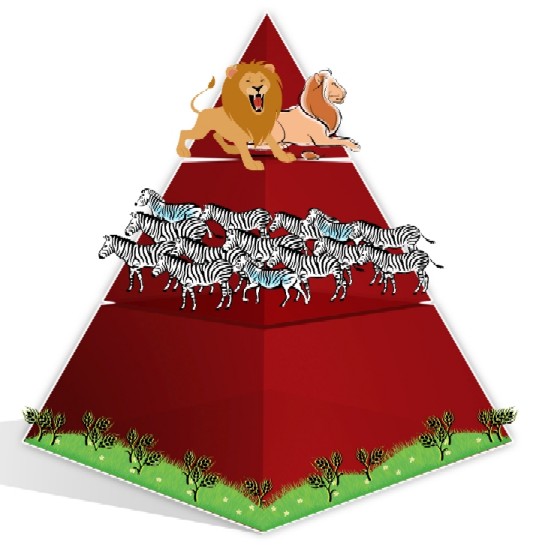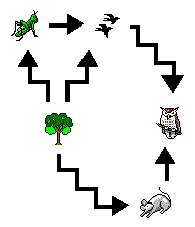Food Chains & Food Webs
Do you like to play games? If you do, you will need energy. Every time you run or jump, you are using up energy in your body. How do you get the energy to play? You get energy from the food you eat. Similarly, all living things get energy from their food so that they can move and grow. As food passes through the body, some of it is digested. This process of digestion releases energy.
A food chain shows how each living thing gets its food. Some animals eat plants and some animals eat other animals. For example, a simple food chain links the trees & shrubs, the giraffes (that eat trees & shrubs), and the lions (that eat the giraffes). Each link in this chain is food for the next link. A food chain always starts with plant life and ends with an animal.
Do you know why there are more herbivores than carnivores?
- Plants are called producers because they are able to use light energy from the Sun to produce food (sugar) from carbon dioxide and water. The process by which plants make food is called photosynthesis.
- Animals cannot make their own food so they must eat plants and/or other animals. They are called consumers. There are three groups of consumers.
- Animals that eat ONLY PLANTS are called herbivores (or primary consumers).
- Animals that eat OTHER ANIMALS are called carnivores.
- carnivores that eat herbivores are called secondary consumers
- carnivores that eat other carnivores are called tertiary consumers
e.g., killer whales in an ocean food web ... phytoplankton → small fishes → seals → killer whales
- Animals and people who eat BOTH animals and plants are called omnivores.
- Then there are decomposers (bacteria and fungi) which feed on decaying matter.
These decomposers speed up the decaying process that releases mineral salts back into the food chain for absorption by plants as nutrients.
Image Map of the Nitrogen Cycle - What happens in the soil?
In a food chain, energy is passed from one link to another. When a herbivore eats, only a fraction of the energy (that it gets from the plant food) becomes new body mass; the rest of the energy is lost as waste or used up by the herbivore to carry out its life processes (e.g., movement, digestion, reproduction). Therefore, when the herbivore is eaten by a carnivore, it passes only a small amount of total energy (that it has received) to the carnivore. Of the energy transferred from the herbivore to the carnivore, some energy will be "wasted" or "used up" by the carnivore. The carnivore then has to eat many herbivores to get enough energy to grow.
Because of the large amount of energy that is lost at each link, the amount of energy that is transferred gets lesser and lesser ...
- The further along the food chain you go, the less food (and hence energy) remains available.
 |
The above energy pyramid shows many shrubs & grass providing food and energy to zebras. Note that as we go up, there are fewer zebras than shrubs & grass and even fewer lions than zebras ... as we go further along a food chain, there are fewer and fewer consumers. In other words, a large mass of living things at the base is required to support a few at the top ... many herbivores are needed to support a few carnivores.
- Most food chains have no more than four or five links.
There cannot be too many links in a single food chain because the animals at the end of the chain would not get enough food (and hence energy) to stay alive.
Most animals are part of more than one food chain and eat more than one kind of food in order to meet their food and energy requirements. These interconnected food chains form a food web.
The following is a possible food web: |
Note that the arrows are drawn from food source to
food consumers ... in other words, you can substitute the arrows
with the words "eaten by" If you are using Internet Explorer, Firefox, Safari or Netscape Navigator (v4) browsers, you may want to have some fun ... creating a possible food web  |
A change in the size of one population in a food chain will affect other populations.
This interdependence of the populations within a food chain helps to maintain the balance of plant and animal populations within a community. For example, when there are too many zebras; there will be insufficient shrubs and grass for all of them to eat. Many zebras will starve and die. Fewer zebras means more time for the shrubs and grass to grow to maturity and multiply. Fewer zebras also mean less food is available for the lions to eat and some lions will starve to death. When there are fewer lions, the zebra population will increase.
Copyright by Alan & Hui Meng
[ Food Chains MCQ ]
[ Worksheets Menu ]
 [ Main Page ]
[ BrainPOP Movie on "Food Chains" ]
[ Main Page ]
[ BrainPOP Movie on "Food Chains" ]
If you have comments or suggestions, ![]() email us at vta_alan@hotmail.com
email us at vta_alan@hotmail.com
SciLinks codes - HSTL440, HSTL445, HSTE595